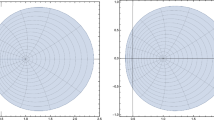Abstract
Die geschichtliche Entwicklung der kosmologischen Modelle für den homogen–isotropen Kosmos, beginnend mit Alexander Friedmanns epochalen Arbeiten (1922 und 1924) bis zur heutigen Diskussion aktueller Modelle wird dargestellt. Eine kardinale Rolle spielt die offene Frage: Besteht die Materie des Kosmos zum weit überwiegenden Teil aus nicht–baryonischer (sog. exotischer) Dunkel–Materie oder reicht die gesamte baryonische Materie aus, die aus den bekannten Atomen und Molekülen besteht, um die Entwicklung des Kosmos zu verstehen. Auch von der normalen (baryonischen) Materie im Kosmos ist nur ein geringer Anteil (etwa 20 \(\pm\) 5 Prozent) in leuchtenden Objekten (Sterne, Gas, Staub) direkt beobachtbar. Im Abschnitt 3 wird der “Einstein–Limit” für die kosmologische Konstante erläutert und eine leicht einsichtige Herleitung des Zahlenwertes gegeben.
Similar content being viewed by others
Author information
Authors and Affiliations
Rights and permissions
About this article
Cite this article
Priester, W., van de Bruck, C. 75 Jahre Theorie des expandierenden Kosmos: Friedmann Modelle und der “Einstein–Limit”. Sci Nat 85, 524–538 (1998). https://doi.org/10.1007/s001140050544
Published:
Issue Date:
DOI: https://doi.org/10.1007/s001140050544




